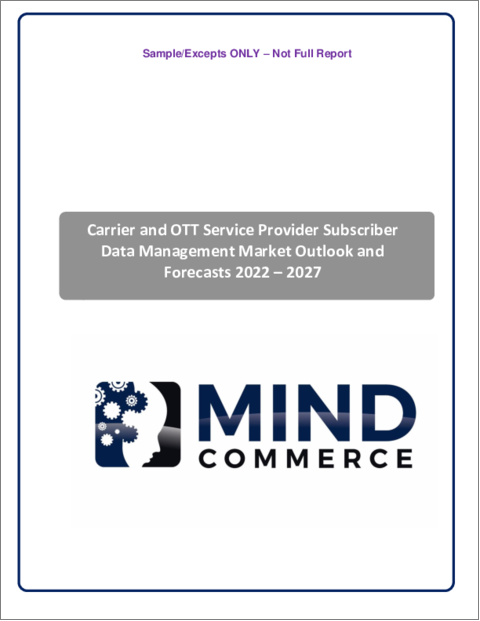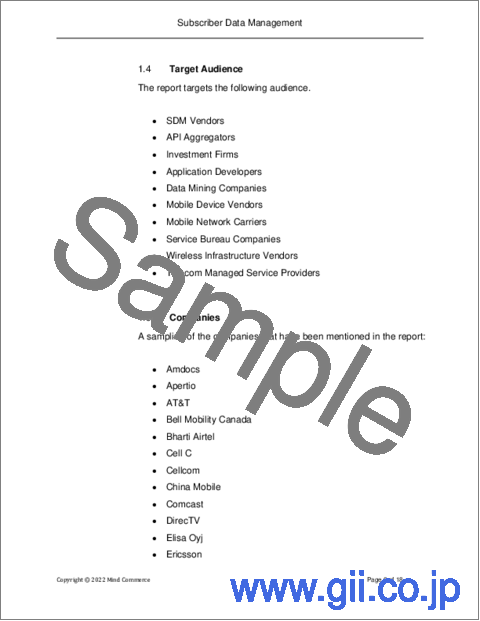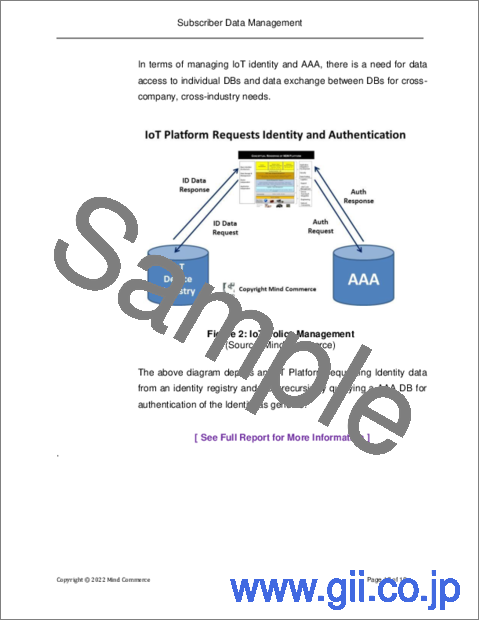|
|
市場調査レポート
商品コード
1080391
加入者データ管理 (SDM) 市場:サービスプロバイダーの種類別 (キャリア、OTTサービスプロバイダー)・ネットワークタイプ (LTE、5G)・モデル別 (構内、クラウド)、地域別 (2022年~2027年)Subscriber Data Management Market by Service Provider Type (Carriers and OTT Service Providers), Network Type (LTE and 5G), Model (Premise and Cloud) and Region 2022 - 2027 |
||||||
| 加入者データ管理 (SDM) 市場:サービスプロバイダーの種類別 (キャリア、OTTサービスプロバイダー)・ネットワークタイプ (LTE、5G)・モデル別 (構内、クラウド)、地域別 (2022年~2027年) |
|
出版日: 2022年05月31日
発行: Mind Commerce
ページ情報: 英文
納期: 即日から翌営業日
|
- 全表示
- 概要
- 目次
加入者データは、世界中の通信事業者にとって重要な商品です。これを活用すれば、加入者の好みに応じて、カスタム化されたサービスや最適化されたアプリケーションを市場に提供できます。そして、高度にフォーカスした新しいアプリケーションやサービスの機会が生まれます。また、加入者データを最適に活用することで、収益の拡大、顧客ロイヤルティの向上、収益性の改善も促進されます。
世界の加入者データ管理 (SDM) の市場規模は、5Gインフラ投資を原動力に拡大し続け、2027年に104億6,000万米ドルに達すると予測されています。地域別では北米が最も大きな恩恵を受け、2027年に352億米ドルに達する見通しです。
当レポートでは、世界の加入者データ管理 (SDM) 市場について分析し、技術の概略やビジネスモデル・バリューチェーン、市場の促進・抑制要因、大手キャリア/ベンダーの主な戦略と展開事例、全体的な市場動向の見通し (2022年~2027年)、サービスプロバイダー別 (キャリア、OTTサービスプロバイダー)・ネットワークの種類別 (LTE、5G)・運用方式別 (構内ベース、クラウドベース) および地域別の詳細動向、といった情報を取りまとめてお届けいたします。
目次
第1章 エグゼクティブサマリー
第2章 加入者データ管理技術
- 次世代SDMに向けた進化
- 加入者データ管理 (SDM) とは
- 加入者データ管理ネットワーク要素
- 旧来の加入者データ管理ソリューション
- LTE・5Gネットワークでの統合データ
- 加入者データ管理の標準化
- 加入者データ管理ソリューションの主な要素
- SDM対応テクノロジー
- データ収集エンジン
- ID管理機能
- 加入者データ管理機能
- 加入者データの連携 (フェデレーション)
- 加入者データ管理の展開シナリオ
- 一元型SDM展開モデル
- 連携型/仮想化SDM展開モデル
- 集中型SDM展開モデル
第3章 加入者データ管理市場のビジネスケース
- 加入者データ管理市場の促進要因
- 資本的支出 (CAPEX)・運用費 (OPEX) の削減
- 加入者のロイヤリティと解約率の削減
- カスタマーエクスペリエンスとサービス提供の向上
- サービスのカスタム化と独自サービスの開発
- ビジネスインテリジェンスアプリケーションの基盤提供
- IDブローカリング:Webプロバイダーとの競合
- ネットワークの高密度化と異種ネットワーク
- プライベートワイヤレスネットワーク
- 加入者データ管理市場の抑制要因
- プライバシーの制約と規制
- 投資支援
- 統合の複雑さ
- 加入者データ管理のバリューチェーン
- 加入者データ管理業界のロードマップ
- ID管理サービスの統合
- SDMAPIの商品化
- MDMとのコンバージェンス
- 加入者データ管理の動向
- データコンバージェンス:ユーザー、アプリケーション、ポリシー
- オープンアーキテクチャ:プラットフォームとAPI
- インテリジェントなデータ管理および情報サービス
第4章 キャリアSDMの導入:ケーススタディ
- Bell Mobility Canada
- Bharti Airtel
- China Mobile
- Cell C South Africa
- Hutchison (H3G)
- Movistar Argentina
- Mobily Saudi Arabia
- Orascom Telecom Algeria
- Sprint
- Safaricom Kenya
- Telenor Pakistan
- TIM Brasil
- TeliaSonera
- Tele2 Sweden
- Verizon Wireless
第5章 世界のSDM市場の分析と予測 (2022年~2027年)
- 世界の加入者データ管理市場 (2022年~2027年)
- 加入者データ管理:キャリア/サードパーティー (2022年~2027年)
第6章 キャリアSDMの市場分析と予測 (2022年~2027年)
- キャリアSDM:構内ベース/クラウドベース (2022年~2027年)
- キャリアSDMの展開:オプション別 (2022年~2027年)
- キャリアSDM:ソリューション別 (2022年~2027年)
- 構内ベースのLTE SDM vs. 5G SDM (2022年~2027年)
- クラウドベースのLTE SDM vs. 5G SDM (2022年~2027年)
- 5G UDM vs. 5GC UDM (2022年~2027年)
- 5GステートフルUDM vs. ステートレスUDM (2022年~2027年)
- 地域別のキャリアSDM市場2022-2027
- 北米市場:国別 (2022年~2027年)
- 南米市場:国別 (2022年~2027年)
- 欧州市場:国別 (2022年~2027年)
- アジア太平洋市場:国別 (2022年~2027年)
- 中東・アフリカ市場:国別 (2022年~2027年)
第7章 サードパーティー・サービスプロバイダーSDMの市場 (2022年~2027年)
- サードパーティーSDM:構内ベース/クラウドベース (2022年~2027年)
- サードパーティーSDMの展開:オプション別 (2022年~2027年)
- サードパーティーSDM:ソリューション別 (2022年~2027年)
- サードパーティーSDM:クラウドデータ管理別 (2022年~2027年)
- マネージドサービスプロバイダーSDM vs. OTTサービスプロバイダーサードパーティーSDM (2022年~2027年)
- サードパーティーSDM市場:地域別 (2022年~2027年)
- 北米市場:国別 (2022年~2027年)
- 南米市場:国別 (2022年~2027年)
- 欧州市場:国別 (2022年~2027年)
- アジア太平洋市場:国別 (2022年~2027年)
- 中東・アフリカ市場:国別 (2022年~2027年)
Overview:
This report provides an assessment of the Subscriber Data Management (SDM) market, including business models, value chain analysis, carrier and vendor strategies, and a quantitative assessment of the industry from 2022 to 2027. The report includes analysis by service provider type (carriers and OTT service providers), network type (LTE and 5G), operational model (premise and cloud-based), and by geographic region of the world.
Select Report Findings:
- Driven by 5G infrastructure investment, the Global SDM market will reach $10.46 billion by 2027
- North America is poised to benefit the most from this trend, becoming a $35.2 billion market by 2027
- Global cloud-based 5G Unified Data Management (UDM) will become a $498 million UDM market by 2027
- Global 5G and LTE SDM will be $4.7 billion at 17.4% CAGR and $1.9 billion at 60.8% CAGR respectively by 2027
- The global market for third-party SDM (OTT and managed services providers) infrastructure will exceed $1.5 billion by 2027
- Centralized data management supported by cloud-based storage and retrieval will enable operational savings of over 50%
Subscriber data is a crucial commodity for network carriers worldwide, as it can be leveraged to provide customized services and optimize applications to the market based upon subscriber preferences. This creates opportunities for new and highly focused applications and services. Optimally leveraging subscriber data also facilitates revenue expansion as well as improved customer loyalty and profitability.
However, access to subscriber data is often a challenge for network operators. This is due largely to subscriber data being stored in a non-unified, distributed architecture that consists of a variety of different network elements and services. This legacy subscriber data architecture approach is often vendor-specific, which makes it costly to establish and maintain a consolidated view of the operational data.
Subscriber Data Management (SDM) systems provide solutions to these problems by unifying subscriber data into a central repository. With this repository, SDM solutions unify cross-domain subscriber data, including identity, location, presence, authentication, services, and access preferences. These data elements may feed multiple applications through an API interface.
An important aspect of SDM is the 3GPP defined Unified Data Repository (UDR) function, which is central to storage and retrieval of data in 5G networks. UDR is also central to the 5G Service Based Architecture (SBA) approach, including application, subscription, authentication, service authorization, policy data, session binding, and application state information.
We estimate that carriers can save over 50 % in OpEx (associated with customer provisioning, administration, and application/service OSS/BSS) with next-generation SDM as compared to legacy non-UDR mechanisms for managing subscriber data. In addition to OpEx savings, SDM solutions allow carriers to reduce churn rates by enabling carriers to personalize services, improve marketing campaigns, and improve overall revenue and customer retention by gaining rich customer insights.
Furthermore, SDM also allows carriers to establish themselves as brokers of subscriber identity through SDM APIs. Driven by internal utilization within carrier services and identity brokering, SDM APIs are anticipated to become a critical asset for 5G SBA-based services realization and operation.
As network operators continue to invest in network modernization and migrate networks towards 5G, vendors from both telecommunications and IT-centric database backgrounds are competing to gain SDM market share. As part of the 5G network build-out, global carriers are committed to continuing the migration toward a unified data environment that began with LTE networks. As a consequence, we expect SDM vendor revenues to reach $10.87 billion by 2027. North America is poised to benefit the most from this trend, becoming a $4.9 billion market by 2027.
Companies in Report:
|
|
Table of Contents
1.0. Executive Summary
2.0. Subscriber Data Management Technology
- 2.1. Evolution Towards Next Generation SDM
- 2.1.1. What is SDM
- 2.1.2. Subscriber Data Management Network Elements
- 2.1.3. Legacy Subscriber Data Management Solutions
- 2.1.4. Converged Data in LTE and 5G Networks
- 2.1.5. Subscriber Data Management Standardization
- 2.2. Key Subscriber Data Management Solution Elements
- 2.2.1. SDM Enabling Technologies
- 2.2.2. Data Collection Engines
- 2.2.3. Identity Management Function
- 2.2.4. Subscriber Data Management Function
- 2.2.5. Subscriber Data Federation
- 2.3. Subscriber Data Management Deployment Scenarios
- 2.3.1. Centralized SDM Deployment Model
- 2.3.2. Federated or Virtualized SDM Deployment Model
- 2.3.3. Converged SDM Deployment Model
3.0. Subscriber Data Management Market Business Case
- 3.1. Subscriber Data Management Market Drivers
- 3.1.1. Capital Expenditure and Operational Expense Reduction
- 3.1.2. Subscriber Royalty and Churn Reduction
- 3.1.3. Elevating Customer Experience and Service Delivery
- 3.1.4. Service Personalization and Development of Unique Services
- 3.1.5. Providing a Foundation for Business Intelligence Applications
- 3.1.6. Identity Brokering: Competing with Web Providers
- 3.1.7. Network Densification and Heterogenous Networks
- 3.1.8. Private Wireless Networks
- 3.2. Subscriber Data Management Market Barriers
- 3.2.1. Privacy Constraints and Regulation
- 3.2.2. Investment Support
- 3.2.3. Integration Complexities
- 3.3. Subscriber Data Management Value Chain
- 3.4. Subscriber Data Management Industry Roadmap
- 3.4.1. Unification of ID Management Services
- 3.4.2. Commercialization of SDM APIs
- 3.4.3. Convergence with MDM
- 3.5. Subscriber Data Management Trends
- 3.5.1. Data Convergence: Users, Applications, and Policies
- 3.5.2. Open Architectures: Platforms and APIs
- 3.5.3. Intelligent Data Management and Information Services
4.0. Carrier SDM Deployment Case Studies
- 4.1. Bell Mobility Canada
- 4.2. Bharti Airtel
- 4.3. China Mobile
- 4.4. Cell C South Africa
- 4.5. Hutchison (H3G)
- 4.6. Movistar Argentina
- 4.7. Mobily Saudi Arabia
- 4.8. Orascom Telecom Algeria
- 4.9. Sprint
- 4.10. Safaricom Kenya
- 4.11. Telenor Pakistan
- 4.12. TIM Brasil
- 4.13. TeliaSonera
- 4.14. Tele2 Sweden
- 4.15. Verizon Wireless
5.0. Global SDM Market Analysis and Forecasts 2022-2027
- 5.1. Global Subscriber Data Management Market 2022-2027
- 5.2. Subscriber Data Management by Carriers and Third-Parties 2022-2027
6.0. Carrier SDM Market Analysis and Forecasts 2022-2027
- 6.1. Premise-based vs. Cloud-based Carrier SDM 2022-2027
- 6.2. Carrier SDM Deployment by Options 2022-2027
- 6.3. Carrier SDM by Solutions 2022-2027
- 6.4. Premise based LTE SDM vs. 5G SDM 2022-2027
- 6.5. Cloud-based LTE SDM vs. 5G SDM 2022-2027
- 6.6. 5G UDM vs. 5G CUDM 2022-2027
- 6.7. 5G Stateful UDM and Stateless UDM 2022-2027
- 6.8. Carrier SDM Market by Region 2022-2027
- 6.8.1. North America Carrier SDM Market by Country 2022-2027
- 6.8.2. South America Carrier SDM Market by Country 2022-2027
- 6.8.3. Europe Carrier SDM Market by Country 2022-2027
- 6.8.4. APAC Carrier SDM Market by Country 2022-2027
- 6.8.5. MEA Carrier SDM Market by Country 2022-2027
7.0. SDM Market by Third-Party Service Provider 2022-2027
- 7.1. Premise-based vs. Cloud-based Third-Party SDM 2022-2027
- 7.2. Third-Party SDM Deployment by Options 2022-2027
- 7.3. Third-Party SDM by Solutions 2022-2027
- 7.4. Third-Party SDM by Cloud Data Management 2022-2027
- 7.5. Managed Service Provider SDM vs. OTT Service Provider Third-Party SDM 2022-2027
- 7.6. Third-Party SDM Market by Region 2022-2027
- 7.6.1. North America Third-Party SDM Market by Country 2022-2027
- 7.6.2. South America Third-Party SDM Market by Country 2022-2027
- 7.6.3. Europe Third-Party SDM Market by Country 2022-2027
- 7.6.4. APAC Third-Party SDM Market by Country 2022-2027
- 7.6.5. MEA Third-Party SDM Market by Country 2022-2027
Figures
- Figure 1: Data Migration to HSS
- Figure 2: IoT Policy Management
- Figure 3: The SDM Value Chain
- Figure 4: The Telecom API Value Chain
- Figure 5: Global SDM Market 2022 - 2027
- Figure 6: Subscriber Data Management by Type 2022 - 2027
- Figure 7: Premise-based vs. Cloud-based Carrier SDM 2022 - 2027
- Figure 8: Carrier SDM Deployment by Options 2022 - 2027
- Figure 9: Carrier SDM by Solutions 2022 - 2027
- Figure 10: Premise based LTE SDM vs. 5G SDM 2022 - 2027
- Figure 11: Cloud-based LTE SDM vs. 5G SDM 2022 - 2027
- Figure 12: 5G UDM vs. 5G CUDM 2022 - 2027
- Figure 13: 5G Stateful UDM and Stateless UDM 2022 - 2027
- Figure 14: Carrier SDM Market by Region 2022 - 2027
- Figure 15: North America Carrier SDM by Country 2022 - 2027
- Figure 16: South America Carrier SDM by Country 2022 - 2027
- Figure 17: Europe Carrier SDM by Country 2022 - 2027
- Figure 18: APAC Carrier SDM by Country 2022 - 2027
- Figure 19: MEA Carrier SDM by Country 2022 - 2027
- Figure 20: Premise-based vs. Cloud-based Third-Party SDM 2022 - 2027
- Figure 21: Third-Party SDM Deployment by Options 2022 - 2027
- Figure 22: Third-Party SDM by Solutions 2022 - 2027
- Figure 23: Third-Party SDM by Cloud Data Management 2022 - 2027
- Figure 24: Managed Services vs. OTT Service Provider SDM 2022 - 2027
- Figure 25: Third-Party SDM Market by Region 2022 - 2027
- Figure 26: North America Third-Party SDM by Country 2022 - 2027
- Figure 27: South America Third-Party SDM by Country 2022 - 2027
- Figure 28: Europe Third-Party SDM by Country 2022 - 2027
- Figure 29: APAC Third-Party SDM by Country 2022 - 2027
- Figure 30: MEA Third-Party SDM by Country 2022 - 2027
Tables
- Table 1: Global SDM Market 2022 - 2027
- Table 2: SDM by Type 2022 - 2027
- Table 3: Premise-based vs. Cloud-based Carrier SDM 2022 - 2027
- Table 4: Carrier SDM Deployment by Options 2022 - 2027
- Table 5: Carrier SDM by Solutions 2022 - 2027
- Table 6: Premise based LTE SDM vs. 5G SDM 2022 - 2027
- Table 7: Cloud-based LTE SDM vs. 5G SDM 2022 - 2027
- Table 8: 5G UDM vs. 5G CUDM 2022 - 2027
- Table 9: 5G Stateful UDM and Stateless UDM 2022 - 2027
- Table 10: Carrier SDM Market by Region 2022 - 2027
- Table 11: North America Carrier SDM by Country 2022 - 2027
- Table 12: South America Carrier SDM by Country 2022 - 2027
- Table 13: Europe Carrier SDM by Country 2022 - 2027
- Table 14: APAC Carrier SDM by Country 2022 - 2027
- Table 15: MEA Carrier SDM by Country 2022 - 2027
- Table 16: Premise-based vs. Cloud-based Third-Party SDM 2022 - 2027
- Table 17: Third-Party SDM Deployment by Options 2022 - 2027
- Table 18: Third-Party SDM by Solutions 2022 - 2027
- Table 19: Third-Party SDM by Cloud Data Management 2022 - 2027
- Table 20: Managed Services vs. OTT Service Provider SDM 2022 - 2027
- Table 21: Third-Party SDM Market by Region 2022 - 2027
- Table 22: North America Third-Party SDM by Country 2022 - 2027
- Table 23: South America Third-Party SDM by Country 2022 - 2027
- Table 24: Europe Third-Party SDM by Country 2022 - 2027
- Table 25: APAC Third-Party SDM by Country 2022 - 2027
- Table 26: MEA Third-Party SDM by Country 2022 - 2027




